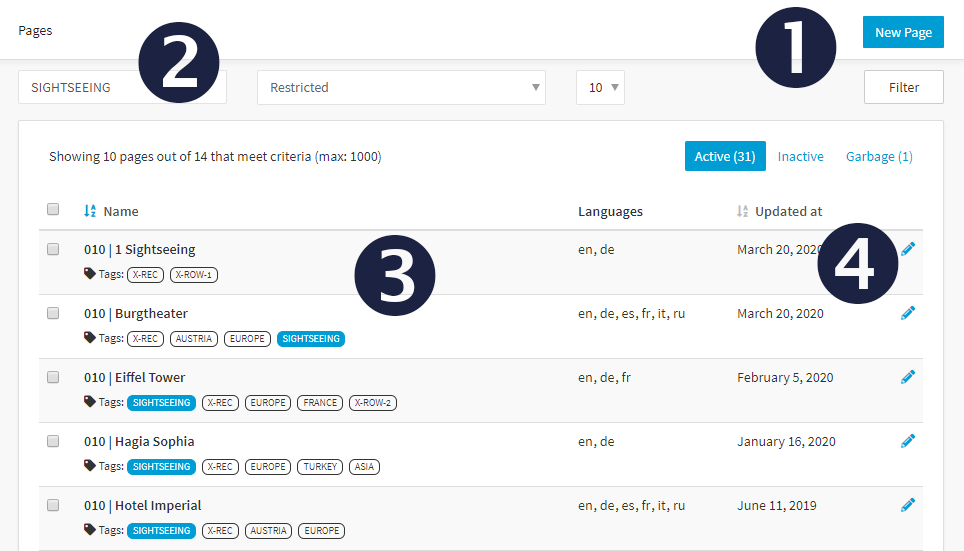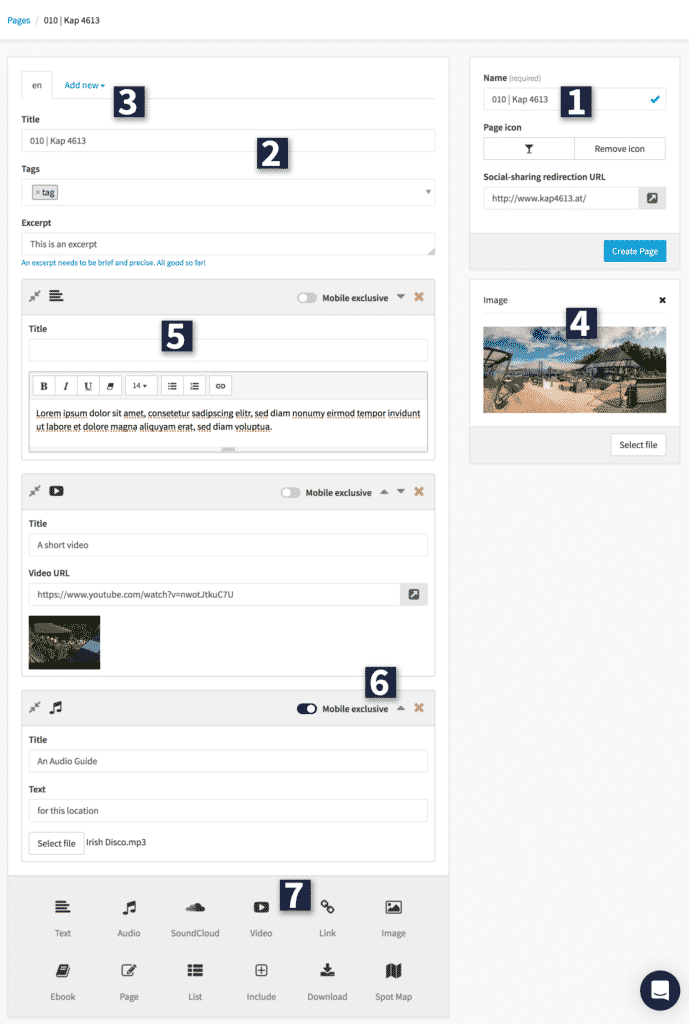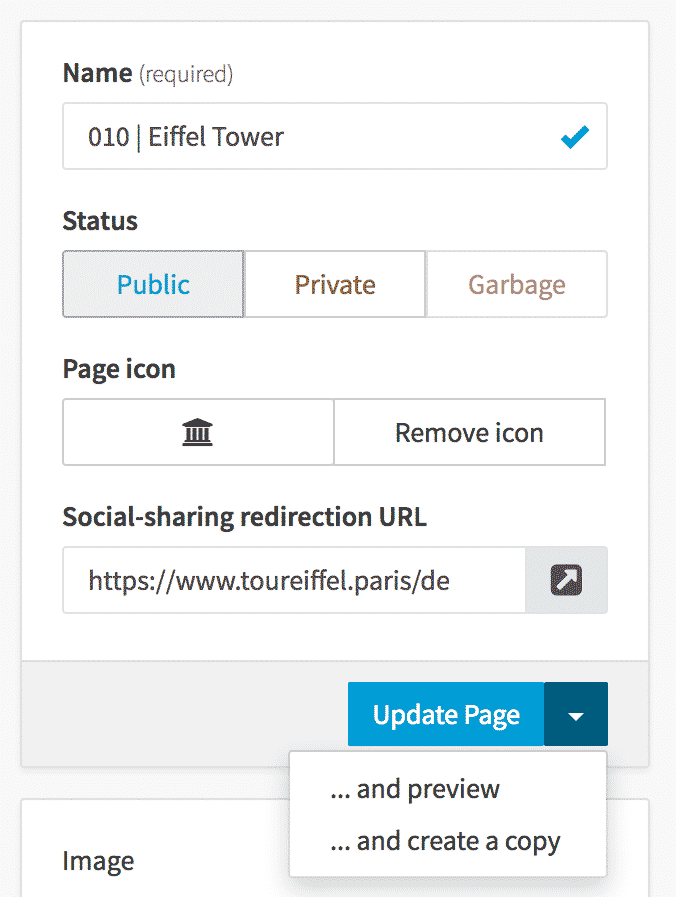Pages
Creating great content.
Creating good content for your guests, customers or prospects is key to success for every marketing effort – be it mobile or not.
Although xamoom gives you all the tools you need for this challenge, the start is always hard but can be mastered with straightforward questions. Just put yourself in the shoes of your users and ask: What would I expect? What content would help me in this situation?
You do know your business, institution, or region best. Empathize with your users. Think of their informational needs or how you want to be entertained in this place or situation.

- Create a New Page by clicking the button in the upper right corner.
- The search lets you find everything in full text. Even if you enter only parts of words (e.g., “sta” instead of “Station”). Through a drop-down selection on the right, you can choose between 10 and 100 pages to be shown at the same time. More load on request.
Search works for the name of the page and their tags. You cannot search for content on a page. - Clicking on a line of a page in the list will open the editing mode.
Below the page's name, all the tags are listed that are associated with this page. You can click on one of the tags to get all pages with the same tag listed. - The status (Public, Private, or Garbage) reveals whether a page is currently in use or ready to be deleted.
This is useful if you have pages that are seasonal and that you don’t want to see if they are currently not in use.
Deleted pages can be restored from the Garbage. Click on a page in the garbage to manage this. On the right, you will find the button Restore.

Pages can have different status
You can change the status of the page for multiple pages at once.
- Select the pages
- Chose the desired state
- Push the button to change status.
Attention: Be aware that end users can not view inactive pages.
You cannot change the state of pages to inactive that are still connected to one or several spots. If you do so, you will get a red warning. Clicking on the question mark in the upper right corner shows you these spots.

Create and edit pages
We developed the content editor with one goal in mind: bringing users quickly to great results.
1. Metadata block
It contains the (internal) name. It identifies the page and is searchable.
If you have chosen a page icon, it shows up (only) once you add the page to the mobile menu.
If you turned on social sharing, you could specify another share URL. This comes in handy if you want your users to share another page – e.g., one from your desktop CMS. This currently works only on the mobile web on Android.
Right below, you find the button to create the page. After creating, it changes its status to update and gives you two more options if you press the right side of the button: preview and copy.
Tip: You can also save a page using the keyboard shortcode [ctrl]+[S] on Windows and [cmd]+[S] on the Mac. For updating and a preview press [ctrl]+[shift]+[S] on Windows and [cmd]+[shift]+[S] on the Mac.
2. Article header
In contrast to the metadata right and tags, the information in this block is shown on pages. It contains a (localized) title and an excerpt.
The excerpt should be brief, descriptive, and motivate the user to go on reading. With a blue, yellow, and red indicator below the excerpt field, we give you a hint of how long it should be.
Using the language tabs at the top, you can switch between languages and add new ones. If you want to add a new language that is not yet part of your system, you need to first turn it on in the settings.
3. Language tabs
Here you switch between and create new language versions for your pages.
4. Cover image
Every page should have its cover image. Click on Select file to open the media picker where you can search for images that you already uploaded or upload one now.
Tip: Be consistent with your cover images. Give them always the same aspect ratio (e.g., 16:9) or choose a distinct color filter for them. This makes a perfect impression on your users.
5. Content blocks
Unlike other CMS where you dump everything into one box, pages in xamoom consist of content blocks. There are various blocks available to you – from text and images to maps and link buttons. Each one is specific to the media it holds.
Every block has an optional Title (Heading 2) and Content depending on its media type.
A content block can be mobile-exclusive (6) (only been shown on phones and tablets). You can change its position using the carets or delete it with the X. If you need more overview, they can be collapsed or expanded with the arrow icons in the upper left corner.
You add content blocks by clicking on their icons (7) at the bottom of a page.
Tip: Empty content blocks lead to an error that prevents you from saving or updating a page. Problematic content blocks identify themselves with a red border.

Preview and page copies
You have now created a page and want to preview it? Easy.
- Clicking on the arrow in the top right corner, next to Update page, will open an option “update page … and preview“. You can also use the the keyboard shortcut [strg]+[shift]+[s] on Windows or [cmd]+[shift]+[s] on the Mac.
- A window opens that contains a fairly accurate preview of your mobile webpage. This is not entirely accurate since there are many different smartphones with different screen resolutions.
- You can also view previews of their respective language versions or see the page in its desktop and tablet version.
- By clicking the x on the top right or a click anywhere on the area outside the preview takes you back to the editing screen.
The above-mentioned dropdown menu gives you another option too: You can create a copy of the page. Using this option brings you to a new page with the same content on it.

How easy it is for you to find all your pages again and to organize them in lists starts at the very beginning with your content strategy. We give you two powerful tools to do that.
- Name of the page: You could introduce a number or letter scheme for all your content.
- Tags are powerful because you can group pages. Specific functions of your apps or the mobile web client also require tags.
You connect internal pages via links in the text editor. However, this is inconvenient for the end-user, and it might break functionality within your app if you have one.
That’s why we introduced two content blocks to do that: pages and lists. Check their functionality above.
Apart from better internal linking, they give your users a big usability advantage: they are bigger and thus, much easier to click.
